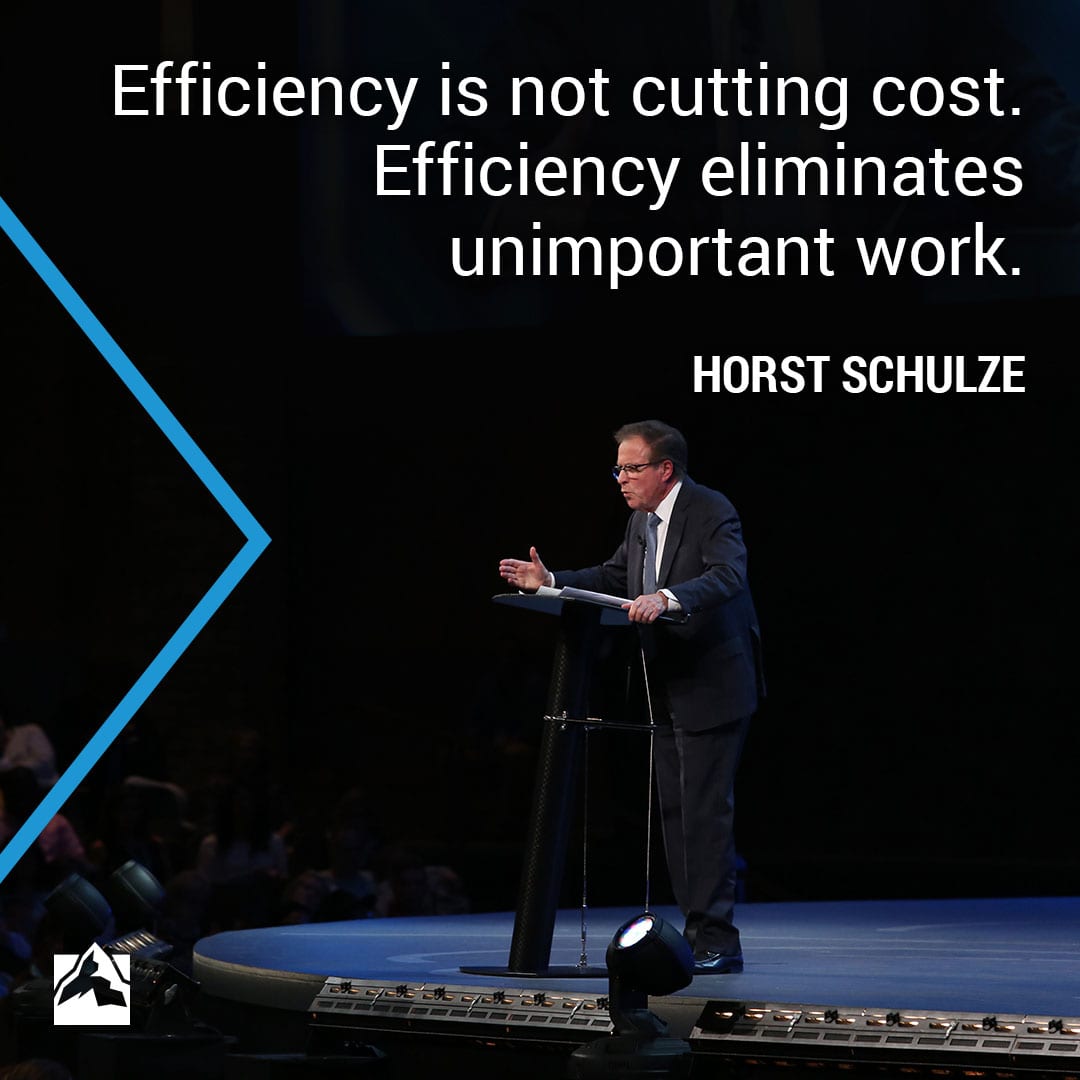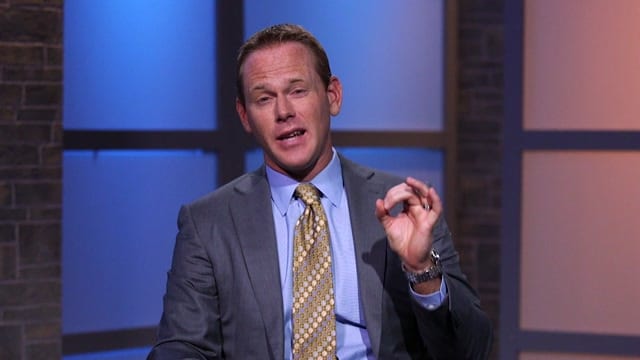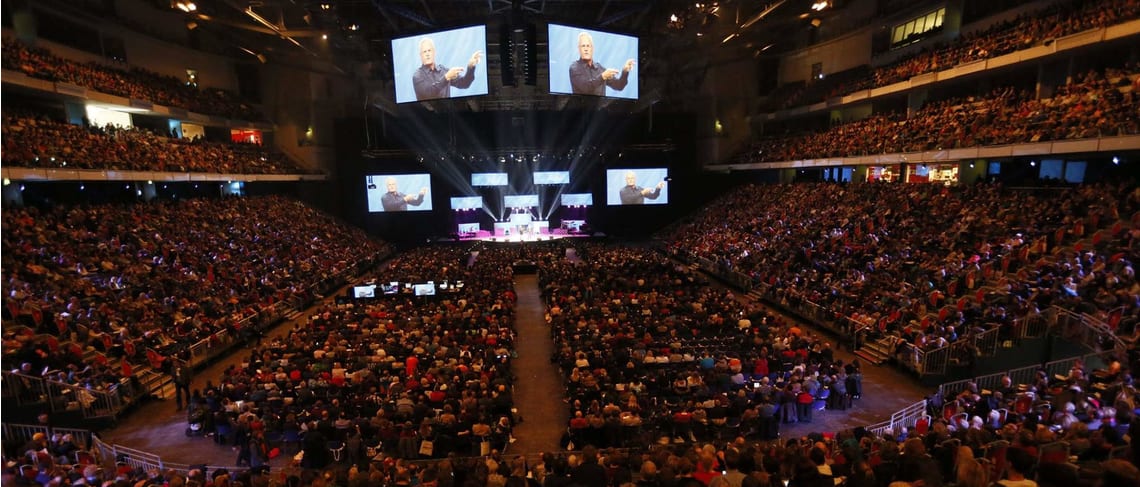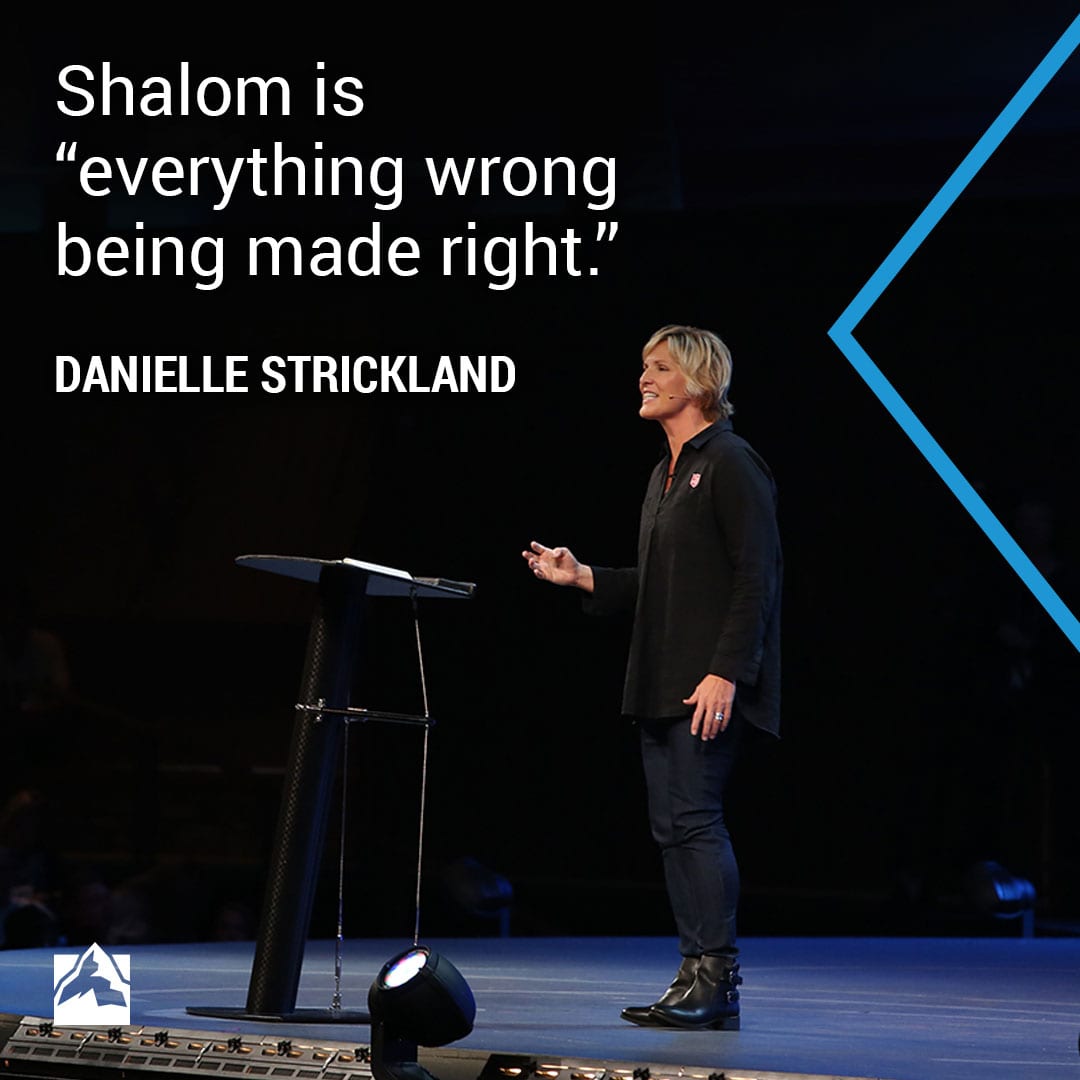
Trust what God has put in your and run after it with all of your heart.

Trust what God has put in your and run after it with all of your heart.

Efficiency is not cutting cost. Efficiency eliminates unimportant work.

You’re in a planning meeting. Your team is developing a product or service to engage and delight your customers or congregation. Maybe you’re developing an exciting new product line or creating a key church service. You’ve thought of every angle . . . but how do you bring your customer’s voice into the conversation?
In this short video above, Daniel Pink (GLS 2010) describes an innovative technique that the folks at Amazon have developed to make sure the end user is represented in their meetings. The video originated on danpink.com.

Your brain won’t work if you’re isolated.

Developing EQ in an organization comes down to recognizing what areas need growth then equipping people with the right process to increase their EQ. Listen to EQ expert, Travis Bradberry, provide coaching backstage at the 2016 Global Leadership Summit.

As The Global Leadership started to become more widely known in the US, more and more people started hearing about the Global Leadership Summit internationally.
In 2005, the leadership team at the Willow Creek Association felt God calling them to serve pastors and leaders, not only in the US, but around the world.
One of the first countries WCA went into was Germany. Now, several years later, we’re hearing multiple stories about the ongoing ripple effect there.
This is just one of those stories.
In Germany, most people don’t even think about planting a new church if they are a part of the traditional Protestant or Lutheran Church. But when Steffen Beck attended the Summit, he was captured by a catalytic idea that would go against everything he had grown to know about the Church in Germany.
To give background to this story, one needs to understand a little bit about the Church in Germany. It is traditionally thought that since Germany is a “Christian country,” there is no need for mission work — Each institutionalized church has its own territory, and generally no one interferes with such territories. Over time, the influence of the state church has faded, and many people are living in a secular society with the leftovers of their tradition.
So when Steffen heard about the concept of the Church being able to transform lives and show God’s work in the community, God began to whisper in his ear about planting a new kind of church.
For Steffen, this radical idea meant leaving his Lutheran church, and facing the consequences of major opposition from what he had come to know as his church family.
But despite this opposition, Steffen remained obedient to God’s whisper.
In 2005, Steffen and a small group of believers he was leading moved into a 400 seat venue with hope that God could do anything.
They called their church, International Christian Fellowship, and came up with a slogan, “Experience church in a new way.”
Today, their church is thriving, and more than a thousand people have started their faith journey there. Since then, they have planted two more churches, and have been impacting their community through social initiatives and their children’s ministry. Their evangelistic heart is strong.
Thanks to a whisper heard from God at the Global Leadership Summit, lives in Germany have been changed.
What did God whisper to your heart during the Global Leadership Summit?

Shalom is “everything wrong being made right.”

 My first question was, “Where’s Clyde, North Carolina?”
My first question was, “Where’s Clyde, North Carolina?”
When Dave Wright, executive director of WCA Church Relations, told me New Covenant Church (NCC) in Clyde, North Carolina was doing an interesting prison ministry in their community, I had never heard of the place. With a population of 1,250, Clyde is located deep in the Smoky Mountains near the Blue Ridge Parkway and is part of Haywood County (population 60,000). That positions Clyde in the middle of the Bible Belt – a friend told me it was the buckle!
I contacted Pastor Nick Honerkamp and arranged to visit the church, learn about its prison ministry and to learn about how he sees the Global Leadership Summit (GLS). He agreed and graciously allowed us to set up our motor home in the church parking lot.
He ended up being one of the most amazing leaders I’ve ever met.
As I spent time with Pastor Nick over the next couple of days, he said Haywood County was home to about 200 churches that were spiritually divided back in 2008. He had a vision to change that. In addition to leading his own church, Pastor Nick sees his role as being a community bridge-builder and spends much of his week working with leaders from all sectors of the community to build ministry coalitions to help meet community needs.
The next morning, Pastor Nick and I attended a prayer meeting for local pastors. It was held at “The Fig Tree,” a building erected to create a space for community prayer. It is unaffiliated with any single church by intention. The doors are open twice a day for two hours, five days a week. All are invited to come and pray for the shared concerns of the community. Different churches often provide worship music and, typically, five to 20 people are present. No one leads, but everyone prays!
Later, Pastor Nick took me to the county jail.
Three years ago, the jail housed 120 prisoners and officials were facing the need to add more cells at a cost of $1,000,000. A few months after a member of NCC was elected sheriff, he called a meeting with county and town officials, key business leaders, social service agency leaders and area pastors.
The sheriff proposed that the assembled leaders begin working together, using private funds, to turn a shut-down federal prison into a homeless shelter, half-way house and soup kitchen. And they did it.
Now, when former prisoners arrive at the new transitional housing, they are greeted by loving church members and encouraged to work with area social agencies that help them find jobs. Last year, 156 prisoners were baptized in the jail—more than at any church in the county!
Today, because of the collaboration across sectors in this community, only 90 prisoners are housed in the county jail. Officials recently closed an annex that housed 30 inmates, saving taxpayers over $1,500, per day!
Later in the week, I went to The Fig Tree and entered into a time of prayer. I asked myself, What was the turning point at the jail? Was it that churches came together for community prayer? Or was it the willingness of leaders from different sectors throughout the region to come together in for a common mission?
Both. It had to be both. The key was these people rejected the silo mentality and built bridges to one another. By engaging leaders from all sectors of the community and building ministry coalitions, Pastor Nick created a regional movement of transformation.
At NCC’s Sunday worship service (approximately 800 people), members seemed abundantly aware they are called to make a difference in their community. And Pastor Nick believes that leadership is at the center of every issue.
He said, “When you are led by faith and bring together leaders from all over your community into a faith-filled environment, unusual things happen. I work to get as many leaders from our community into the GLS. It’s awesome to be a part of what happens next.”
We were blessed and in awe of this amazing church and its leader! We planned to visit for one night and stayed eight.
I have come to believe it is because they see themselves as bridge-builders who create a spirit of collaboration throughout their community.
They have a generous spirit of giving freely to others.
They have a love for one another and their community.
They are dedicated to prayer.
And they have a leader with a steadfast commitment to follow Jesus no matter where He leads.

The world is crying out for rightness and truth.

Surprisingly, interactions with people from different regions within the United States often require cross-cultural skills.
They couldn’t hide it. Their eyes darted around the table to each other. Smiles were restrained or at least covered with a surreptitious move of the hand. I had crossed the line again without fully realizing it.
“I said ‘y’all’ again, didn’t I?”
Nods, grins, smiles, even a snort of laughter, broke through the repressed amusement and we were finally able to get on with the meeting. Forty minutes later, I walked away with two emerging truths echoing through my mind: 1) Never say “y’all” to Minnesotans and 2) “Cultural differences” aren’t always international in nature.
When I listened to Erin Meyer at the 2016 Global Leadership Summit, I was absolutely intrigued by her insightful observations about communicating across cultures. However, I wasn’t convinced that it would connect to much of my daily life. In my role with the Willow Creek Association, I travel to different host site locations primarily located in the Midwest region of the United States – a region not particularly known for its rich cultural diversity.
Or so I thought.
Over the past six months, I’ve been stunned at the distinctions and differences that exist between Americans who live in the same country, residents who live in the same state and even citizens who live in the same town. If your area of leadership or line of work deals with regional offices or nationwide delivery of products and services, then you already know what I’m talking about.
A river that runs through a city isn’t just geography, it often cuts across the city culture like a knife, separating “us” and “them.”
An accent doesn’t just identify you; it can typecast you into a regional perception of “those kinds of people.”
Starting a meeting on time makes you “efficient” in some places, “late” in others, and “militant” in others.
Leaders, it’s simply a mistake to take a “one size fits all” approach, even within your own culture. If you’ve ever run into this phenomenon, or have a role like mine that regularly brings you into contact with people from across different regions (or cultures), here are four tips that have helped me navigate the differences that are literally all around us.
The truth is we all have our own leanings when it comes to cultural do’s and don’ts. The key is being able to recognize yours and at the same time not to judge or look down on someone else’s. One of the best ways I’ve learned to do this is by choosing to enjoy the uniqueness of wherever I am and whomever I’m with.
For example, I grin whenever I hear a Minnesotan say, “Doncha know?” (or basically any syllable with “oh” in it) just like they smirk at my “y’alls”. When I’m in Texas, I graciously accept every TexMex meal I’m treated to, and delight in the fact that it only comes in one size: Gigantic.
I don’t need to enforce my personal norms – being with another culture is a chance to stumble across differences and savor them. Sometimes the differences create friction, but I find if I approach them with the predetermined choice to have fun and enjoy it, I navigate through friction faster because I’m not forcing other people to perform according to my preferences.
When I’m with an individual or a group from a different region or culture, I consciously try to adjust my ratio of listening vs. speaking. There’s so much you can learn from the people you’re with if you’ll make a deliberate attempt to listen to them.
What priorities matter to them? What are their values, concerns and ideas about the matter we’re discussing? We may not always have the luxury of hours to meet and discuss these things, but you’d be surprised by what you can pick up in 20 minutes by choosing to ask questions that draw out their responses and then simply listening.
Probably the biggest mistake you can make is to try and emulate someone else’s culture. It’s like trying to copy someone’s accent – they recognize it immediately and it only highlights that you “aren’t from around here.”
While there’s room for respecting what they value (be it timeliness, personal space or how they use email), there’s no need to copycat them. What almost every culture values (certainly in the United States) is authenticity. In short, they don’t want you to be them – they want the actual you – but they are looking for someone who “gets them.” In other words, someone who appreciates or enjoys them for who they are. (Sound familiar? See my first point).
Sorry to break the rhythm of the previous three principles, but in my experience, one of the fastest ways around cultural roadblocks (international, regional or otherwise) is to share a meal together. No matter who you are or where you’re from, everybody eats. To sit at a table and eat together emphasizes our humanness and our similarities. It’s often a chance for the locals to show off their cuisine – yet another chance to enjoy and celebrate them for who they are. (And you never know, you may just end up with a new favorite dish!)
While there are undoubtedly more tips to add to the list, I find these four have become a traveling “playbook” that are easy to remember and employ on the fly.
Regardless of the approach you take, the truth is there’s a world of cultural differences out there, and they are always closer than you think – maybe even just across the street. As leaders, we have the unique opportunity to embrace the distinctives while finding the common ground we can build on together.
That is, if y’all understand what I’m saying.
“We welcome and encourage comments on this site. There may be some instances where comments will need to be edited or removed, such as:
If you have any questions on the commenting policy, please let us know at heretoserve@globalleadership.org”
Recent Comments